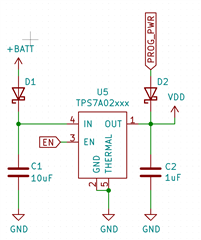Hi Experts,
Seeking your assistance to this query:
I am designing a product which is powered from a battery (+BATT) via the TPS7A0222 regulator. A Programmer may be connected to the MCU directly to program the device at 3.3V, powered via PROG_PWR which is on the regulator's output. The circuit diagram is attached below.
While the battery is diode protected via D1, if the battery is dead, C1 will be 0 volts. In this case, if the programmer is connected, reverse current will flow from the output to the input to charge C1 (10uF).
The datasheet is not specific how much reverse current will damage the device, only specifying: This reverse current flow can cause damage to the device. Limit reverse current to no more than 5% of the device rated current for a short period of time.
Thank you.
Regards,
Archie A.


